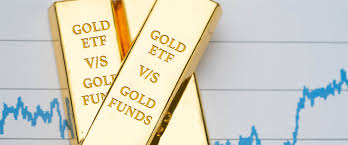Gold exchange-traded funds (ETFs) in India are rapidly gaining traction, particularly as investors seek safer investment options amid rising geopolitical tensions and fluctuating market dynamics. Unlike traditional investments in physical gold, gold ETFs offer a convenient and regulated avenue for individuals to invest in this precious metal while benefiting from its perceived stability.
Understanding Gold ETFs
Gold ETFs are essentially mutual fund schemes that invest in gold bullion of 99.5% purity. These funds are passively managed and aim to track the domestic price of gold closely. As of now, India boasts 17 different gold ETFs, with prominent ones including Nippon India ETF Gold BeES, HDFC Gold ETF, and SBI Gold ETF, all of which manage significant assets.
Investors find gold ETFs appealing for several reasons. They provide a liquid and transparent investment vehicle that mirrors the market price of gold. Moreover, gold ETFs eliminate the need for physical storage, which can be cumbersome and fraught with risks such as theft and purity concerns.
Performance Insights
The performance of gold ETFs in India has been noteworthy. Over the past year, these funds have averaged returns of approximately 29.12%. Their three-year and five-year returns stand at 16.93% and 13.59%, respectively. Certain ETFs, like the LIC MF Gold ETF, have delivered slightly higher returns, achieving 29.97%, 17.47%, and 13.87% over one, three, and five years, respectively. This performance, although slightly lower than that of physical gold, highlights the potential for gold ETFs as a viable investment alternative.
Experts suggest that gold ETFs are increasingly favored due to their liquidity, transparency, and alignment with global gold prices. In light of the escalating geopolitical tensions, these funds are particularly attractive as they serve as a “safe haven” for investors looking to mitigate risk.
Significant Growth in Assets Under Management
The growth trajectory of gold ETFs in India has been impressive, with a seven-fold increase in assets under management (AUM) from Rs 5,613.22 crore in September 2019 to Rs 39,823.50 crore in September 2024. This surge in AUM reflects a growing preference for gold ETFs as a primary investment choice, especially in light of upcoming festivals like Dhanteras, which typically see a spike in gold purchases.
Inflows into gold ETFs have skyrocketed, with a nearly 88% increase since the beginning of 2024. By September 2024, the inflows amounted to Rs 1,232.99 crore, up from Rs 657.46 crore in January of the same year. This trend demonstrates that Indian investors are recognizing the advantages of gold ETFs, particularly their liquidity and cost-effectiveness compared to physical gold investments.
Investment Considerations
For investors contemplating gold ETFs, experts recommend a strategic approach, especially for those with a short to medium-term investment horizon. Adopting a “buy on dips” strategy can capitalize on temporary price corrections, enabling investors to maximize returns. With the current mixed trends in equity markets, a modest allocation to gold may serve as an effective hedge against inflation and market volatility.
The expectation of interest rate cuts by central banks, particularly the U.S. Federal Reserve, may further bolster investor interest in gold ETFs. This is because lower interest rates can enhance the appeal of gold, reducing the opportunity cost of holding non-yielding assets.
Global Perspective on Gold ETFs
The enthusiasm for gold ETFs is not limited to India; globally, these funds have also experienced remarkable growth. In September 2024, gold ETFs worldwide saw net inflows for the fifth consecutive month, with North America leading the charge. The total assets under management of gold ETFs rose by 5%, reaching $271 billion. This uptick in global gold holdings reflects a growing demand for safe-haven assets amid ongoing geopolitical uncertainties.
Asian markets have notably dominated global inflows in gold ETFs, despite a recent slowdown in demand. However, some regions, particularly Europe, experienced outflows. In the UK, for example, investor sentiment was tempered due to the Bank of England’s cautious approach to interest rates, which contrasted sharply with the Federal Reserve’s easing measures.
Safety and Regulation
One of the key advantages of investing in gold ETFs is the regulatory framework that governs them. These funds are subject to stringent regulations, providing a layer of safety that is often lacking in physical gold investments. Investors can trade gold ETFs on stock exchanges in real-time, allowing for greater flexibility and ease of access.
Moreover, concerns regarding the purity and safety of physical gold investments have led many investors to favor ETFs. Unlike physical gold, which requires secure storage and poses risks of theft and counterfeit products, gold ETFs streamline the investment process while ensuring compliance with quality standards.
The Future of Gold ETFs
As gold ETFs continue to gain traction, they are emerging as a preferred investment choice for individuals seeking a blend of safety, liquidity, and strong returns. The current market dynamics, characterized by geopolitical tensions and fluctuating interest rates, suggest that gold will remain a popular asset class.
Investors are encouraged to consider the potential of gold ETFs as a strategic component of their portfolios. With their robust performance and regulatory safety nets, these funds represent a modern and effective way to invest in gold without the traditional hassles associated with physical ownership. As the gold ETF market expands and evolves, it is essential for investors to stay informed about market trends and performance indicators. With careful planning and strategy, gold ETFs can provide a stable and rewarding investment avenue in an ever-changing financial landscape.




